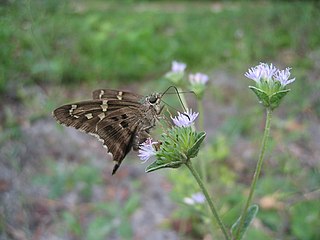
The long-tailed skipper is a spread-winged skipper butterfly found throughout tropical and subtropical South America, south to Argentina and north into the Eastern United States and southern Ontario. It cannot live in areas with prolonged frost. It is a showy butterfly, with wings of light brown tinted with iridescent blue, and two long tails extending from the hindwings. The robust body is light blue dorsally. It has a large head, prominent eyes, and a wingspan between 4.5 and 6 centimeters.

Ancyloxypha numitor, the least skipper, is a North American butterfly in the family Hesperiidae. They have a weak, Satyrinae-like flight.

Burnsius oileus, the tropical checkered skipper, is a species of skipper. It is found from Peninsular Florida, the Gulf Coast, and southern Texas, south through the West Indies, Mexico and Central America to Costa Rica. It was transferred to genus Burnsius in 2019, and was previously known as Pyrgus oileus.

Amblyscirtes hegon, the pepper-and-salt skipper, is a butterfly of the family Hesperiidae. It is found from Nova Scotia and Maine, west to southern Manitoba, south to Georgia, northern Florida and south-eastern Texas. It is mostly absent from the coastal plain.

Amblyscirtes vialis is a butterfly of the family Hesperiidae. It is found from British Columbia east across southern Canada to Maine and Nova Scotia, south to central California, northern New Mexico, Texas, the Gulf states and northern Florida.
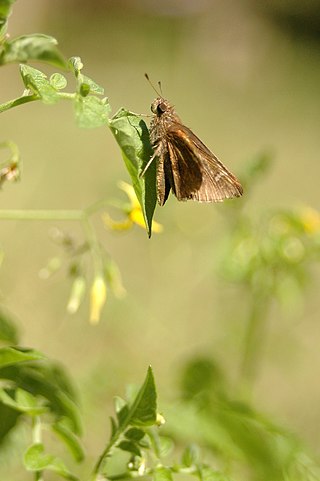
Lerema accius, the clouded skipper, is a butterfly of the family Hesperiidae. It is found in the United States from Georgia west to Texas, south to Florida, and south through Mexico and Central America to Venezuela and Colombia.

Lerodea eufala, the Eufala skipper or rice leaffolder, is a species of butterfly in the family Hesperiidae. It is found from the coast of Georgia, south through Florida and west across the southern United States to southern California, south through Mexico and Central America to Patagonia. In the summer, it expands its range north to central California, North Dakota, southern Wisconsin, northern Michigan and Washington, D.C.

Calpodes ethlius, the Brazilian skipper, larger canna leafroller or canna skipper, is a butterfly of the family Hesperiidae. It is found in the United States from southern Florida and southern Texas, south through the West Indies, Mexico, and Central America to Argentina. Strays and temporary colonies can be found north to southern Nevada, northern Texas, Illinois and Massachusetts.

Wallengrenia egeremet, the northern broken dash , is a butterfly of the family Hesperiidae. It is found in North America from southern Maine and southern Ontario, west across the Great Lakes states to southeastern North Dakota, south to central Florida, the Gulf Coast and south-eastern Texas.

Wallengrenia otho, the southern broken dash or broken dash skipper, is a butterfly of the family Hesperiidae. It was originally described by Smith in 1797. It is found from eastern Texas and the southeastern United States, south through the West Indies and Central America to Argentina. Strays can be found as far north as central Missouri, northern Kentucky and Delaware.

Atrytone arogos, the arogos skipper or beard-grass skipper, is a butterfly of the family Hesperiidae. It is found in the United States in isolated colonies in Georgia, peninsular Florida, the Gulf Coast, south-east North Dakota and central Minnesota south to southern Texas and the Colorado Front Range. Strays are found up to western Virginia, northern Arkansas and Illinois.
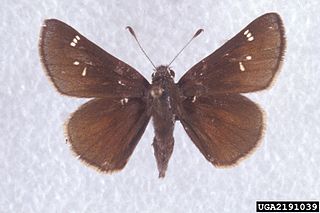
Atrytonopsis hianna, the dusted skipper, is a butterfly of the family Hesperiidae. It is found in the United States from eastern Wyoming, central Colorado, northern New Mexico and central Texas east to New Hampshire and Massachusetts, south to peninsular Florida and the Gulf Coast.
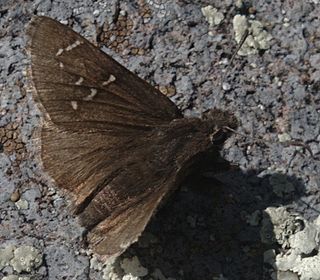
Thorybes mexicana, the Mexican cloudywing, mountain cloudy wing or Nevada cloudy wing, is a butterfly of the family Hesperiidae. It is found in the high elevation mountains of the western United States south into Mexico.

Eurema daira, the fairy yellow, barred yellow or barred sulphur, is a butterfly of the family Pieridae. The species was first described by Jean-Baptiste Godart in 1819. It is found from Argentina north to the southern United States. Strays can be found up to southern Arizona, South Dakota, southern Texas and even Washington, D.C.
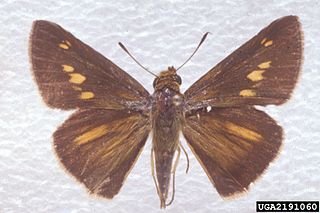
Euphyes dion, the Dion skipper or Alabama skipper, is a species of butterfly of the family Hesperiidae. It is found in scattered populations along the Atlantic coast of North America, from western Massachusetts and south-eastern New York south to north-eastern Florida, west to north-eastern Texas, and north to south-eastern North Dakota, northern Wisconsin, southern Ontario and southern Quebec. It is listed as a species of special concern in the US state of Connecticut.

Oarisma garita, the Garita skipperling, western skipperling or Garita skipper, is a North American butterfly in the family Hesperiidae (skippers), subfamily Hesperiinae . This skipper ranges southeastern Manitoba to British Columbia and south through the American Midwest as far south as Mexico. Its habitats include dry or moist prairies, open woodlands, and limestone outcrops.

Satyrium favonius, the oak hairstreak or southern hairstreak, is a butterfly of the family Lycaenidae. It is found in the United States from southern New England and the Atlantic Coast south to peninsular Florida and west to central Illinois, south-eastern Colorado and the Gulf Coast.
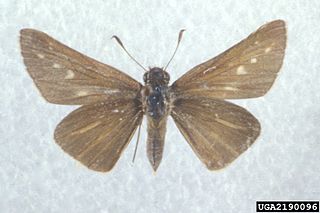
Panoquina panoquin, the salt marsh skipper, is a butterfly of the family Hesperiidae. It is found along the Atlantic Coast of the United States, from New York south to Florida and the Florida Keys, west along the Gulf Coast to southern Texas.

Anthanassa texana, the Texan crescentspot, is a species of butterfly in the family Nymphalidae. It is found from Guatemala north through Mexico to southern California, east across the southern United States to northern Florida, Georgia and South Carolina. Strays may be found up to Arkansas, Missouri, Illinois, South Dakota, and central Nevada. The habitat consists of deserts, dry gulches, open areas, streamsides, road edges, and city parks.

Hemiargus ceraunus, the Ceraunus blue, is a butterfly in the family Lycaenidae. The species was first described by Johan Christian Fabricius in 1793. It is found in the southwestern United States, southern Texas, Florida and the Florida Keys south through the West Indies, Mexico and Central America to South America. Strays may be found in North Carolina, Missouri, Kansas and Nevada. The habitat consists of open woodland, desert scrub, dunes, pastures, road edges and vacant lots.






















